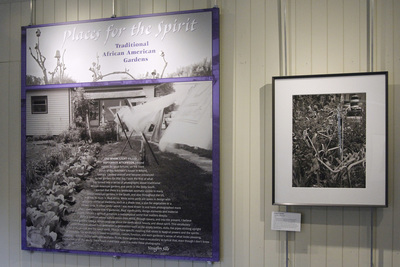Places for Spirit
by Jenny Miller Sechler
Places for the Spirit, documents photographer Vaughn Sills’ exploration of the gardens in the deep South. For over twenty years, Sills traveled through small southern towns and countryside, drawn to personal gardens that are at once unique and traditional, reflective of an African American, southern aesthetic that is fading from the landscape. Sills’ photographs capture the poetic language of these gardens and their serene, protective and spiritual essence. As she says in an artist’s statement accompanying the exhibit: “Within a history that comes from Africa, through slavery, and into the present, I believe these gardens speak a certain language about the earth, about beauty, and about the spirit.”
Through September 30, the Lyman Plant House at Smith College is hosting an exhibition of Sills’ photographs along with accompanying materials about Sills’ travel and methods. The work is on display in the Church Exhibition Gallery, a small, beautifully lit space with doors opening into a series of greenhouses, making it a perfect place to view Sills’ captivating photographs. Contrary to what one might expect for garden photography, Sills’ prints are all in black and white. Her use of black and white allows her to emphasize the space created by each garden’s layout, and often lends a mysterious quality to the photographs.
Sills’ 2001 photograph of L. V. Hull’s garden in Kosciusko, Mississippi, shows the gardener’s use of found objects that bring order to the lush vegetation. Hull was known in her community for her use of colorfully painted shoes – from women’s pumps to running shoes – arranged on sticks rising out of her plant beds. In Sills’ photograph, the shoes form a row of vertical lines that draws the viewer’s eyes to tower of tires, painted white, that are stacked around Hull’s porch in the upper right corner. Spherical objects and metal suns hang from the porch roof and banisters. While the effect sounds dizzying, Sills’ captures Hull’s logic and artistry and the results are surprising and magical.
Many of the objects in Hull’s garden appear over and over again in other gardens captured in this series. The objects used are dictated by each gardener’s taste and artistic vision but also reflect spiritual beliefs and cultural practices. For instance, in a January 2015 essay for Art Times, Leigh Donaldson notes that the use of circles as a visual theme – found in abundance in Hull’s garden as well as others – represents movement and the cycles of nature. “Bottle trees,” or trees with bottles placed over their branches or coiled wire, are also present in many of Sills’ photographs. While bottle trees add a compelling creative element to these gardens, playing with light and reflection, these trees were originally meant to fill a functional role, protecting a home from evil spirits by capturing and trapping them in the bottles.
One of Sills’ photographs of Henry Thompson’s garden offers a beautiful example of the dual nature of bottle trees. The photograph is a close of two bottles strung on a wire reaching up towards the sky. One of the bottles is cloudy and opaque. Shot through with bright light behind it, the bottle is ghostly and mysterious. The angle of the bottles echoes the branches behind it, which are vague and shaky, giving the photograph an overall impression of otherworldliness.
While Sills captures the unique beauty of each garden, her portraits of the gardeners are equally moving. The gardeners appear relaxed, completely in their element. A portrait of Annie Walker, taken at her Athens Georgia in 1989, is particularly soft and serene; the viewer can almost feel the folds on Walker’s dress. Sills’ portrait of gardener Pearl Fryar is the one exception to the peaceful quality in other portraits. Rather than relaxing on the porch, Fryar is pictured kneeling in his garden. His posture is tense, and this, combined with the hose visible on the ground behind him, lets the viewer know he is ready to get back to work. He shows a sense of direction and purpose.
Sills’ portraits make visible the contentment each subject finds in his or her garden, underlining the emotional connection between the gardener and the earth. A close relationship with nature and agriculture is an important part of African American history, brought from African traditions and kept alive even while they were held in bondage. “To be fully free, one had to embrace the organic rights of the earth,” notes African American author bell hooks in her essay Earthbound on Solid Ground. She adds, “To tend to the earth is always then to tend our destiny, our freedom, and our hope.”
Smith College’s Lyman Plant House is adjacent to the college’s botanical garden, which features a lily pond, a rock garden, and borders of diverse, vibrant flowers, as well as neat, labeled beds highlighting specific plant species. The contrast between this orderly, English style landscape and the gardens featured in Sills’ photographs enriches the visitor’s experience of the exhibit. This is especially true for native New Englanders, who may be more used to the Smith style gardens. When we have an opportunity to experience a different landscape aesthetic, even if it’s just through photography, we become more consciously aware of the choices horticulturalists make in their work, and this broadens our awareness of horticulture as an art form.
Places for the Spirit: Traditional African American Gardens will be on display through September 30, 2015 at the Lyman Plant House, Smith College, 16 College Lane, Northampton, MA.
________________________________________________________________________________________________
Image Credit: Photos by Pamela Dods.
________________________________________________________________________________________________
Jenny Miller Sechler is an arts writer living in Northampton, Massachusetts, where she serves on the board of Northampton Arts, Inc.



